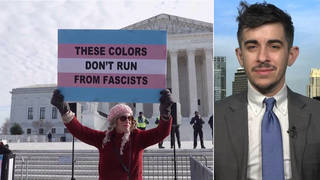
Related
Topics
Guests
- Adam Cohenauthor of Imbeciles: The Supreme Court, American Eugenics, and the Sterilization of Carrie Buck. He was previously a member of The New York Times editorial board and a senior writer for Time magazine. He is the co-editor of TheNationalBookReview.com.
As President Obama nominates centrist Judge Merrick Garland to replace late Justice Antonin Scalia on the Supreme Court, we take a look at what’s been described as one of the worst Supreme Court rulings in history. In the 1927 case Buck v. Bell, the court upheld a statute that enabled the state of Virginia to sterilize so-called mental defectives or imbeciles. The person in question was Carrie Buck, a poor, young woman then confined in the Virginia State Colony for Epileptics and the Feebleminded, though she was neither epileptic nor mentally disabled. In the landmark decision, eight judges ruled that the state of Virginia had the right to sterilize her. Justice Oliver Wendell Holmes Jr. wrote the majority opinion concluding, “Three generations of imbeciles are enough.” The decision resulted in 60,000 to 70,000 sterilizations of Americans considered “unfit” to reproduce. At the Nuremberg trials, lawyers for Nazi scientists cited the opinion in defense of their actions. We speak to Adam Cohen, author of “Imbeciles: The Supreme Court, American Eugenics, and the Sterilization of Carrie Buck.”
Transcript
NERMEEN SHAIKH: We turn now to look at what’s been described as one of the worst Supreme Court rulings in history. In the 1927 case Buck v. Bell, the court upheld a statute that enabled the state of Virginia to sterilize so-called mental defectives or imbeciles. The person in question was Carrie Buck, a poor, young woman then confined in the Virginia State Colony for Epileptics and the Feebleminded, though she was neither epileptic nor mentally disabled. In the landmark decision, eight judges ruled that the state of Virginia had the right to sterilize her. Her mother, Emma, as well as Carrie’s daughter, Vivian, then only eight months old, were deemed similarly deficient. Justice Oliver Wendell Holmes Jr. wrote the majority opinion concluding, quote, “Three generations of imbeciles are enough.”
AMY GOODMAN: The decision resulted in 60,000 to 70,000 sterilizations of Americans considered “unfit” to reproduce. The Supreme Court decision had its origins in the eugenics movement then thriving in the United States. The 1924 Immigration Act was passed with similar intent—to prevent immigration by genetically inferior groups, which included Italians, Jews, Eastern Europeans and countless others, in an attempt to improve the genetic quality of the American population.
Author Adam Cohen writes about the case in his new book, Imbeciles: The Supreme Court, American Eugenics, and the Sterilization of Carrie Buck. Adam was previously a member of The New York Times editorial board and a senior writer for Time magazine. He is the co-editor of TheNationalBookReview.com.
Adam Cohen, welcome back to Democracy Now! It’s great to have you with us.
ADAM COHEN: Great to be here, Amy.
AMY GOODMAN: Tell us the story of Carrie Buck. In a moment, we’ll hear all about how it ties into immigration, eugenics, parallels to what we’re seeing today. But start back in the 1920s with Carrie Buck.
ADAM COHEN: So she’s a young woman who is growing up in Charlottesville, Virginia, being raised by a single mother. Back then, there was a belief that it was better often to take poor children away from their parents and put them in middle-class homes. So she was put in a foster family that treated her very badly. She wasn’t allowed to call the parents “mother” and “father.” She did a lot of housekeeping for them and was rented out to the neighbors. And then, one summer, she was raped by the nephew of her foster mother. She becomes pregnant out of wedlock. And rather than help her with this pregnancy, they decide to get her declared epileptic and feebleminded, though she was neither, and she’s shipped off to the Colony for Epileptics and Feebleminded outside of Lynchburg, Virginia.
AMY GOODMAN: And what happened to her there?
ADAM COHEN: So she gets there at just the wrong time. Virginia has just passed an eugenics sterilization law, and they want to test it in the courts. So they seize on Carrie Buck as the perfect plaintiff in this lawsuit. So they decide to make her the first person in Virginia who will be eugenically sterilized, and suddenly she’s in the middle of a case that’s headed to the U.S. Supreme Court.
NERMEEN SHAIKH: And, Adam Cohen, could you explain what kind of medical tests were employed to determine that she was a so-called imbecile?
ADAM COHEN: Yeah, terrible testing. These were very primitive IQ tests from the time, that really didn’t test intelligence at all. One question she was asked was: What do you do when a playmate hits you? And whatever her answer was to that was somehow deemed to be relevant to whether or not she was an idiot, an imbecile or a moron.
AMY GOODMAN: Those were the categories?
ADAM COHEN: Yes, those were the three categories. And this was a formal hierarchy that was established by the psychological profession at the time and was actually in government pamphlets. So, if you were of a mental age of two or younger, you were called an idiot. If you were between three and seven, you were called an imbecile. And if you were eight and—from between eight and 12, you were called a moron. And Carrie and her mother, who was also at the colony, were deemed to be morons.
NERMEEN SHAIKH: And so, explain what happened to Carrie after that.
ADAM COHEN: Yeah, so, they decide to put her in the middle of this test case to see if the Virginia law is constitutional. And they give her a lawyer who’s actually not on her side. It’s a former chairman of the Colony for Epileptics and Feebleminded’s own board of directors. He clearly wants to see her sterilized. He does a terrible job writing short briefs that don’t cite the relevant cases. It goes up to the Supreme Court, and the court rules eight to one that, yes, the Virginia law is constitutional, and, yes, Carrie, who there’s nothing wrong with, should be sterilized against her will.
NERMEEN SHAIKH: And who was responsible for appointing this lawyer to her?
ADAM COHEN: It was the colony itself, so they chose one of their friends. And she truly had no advocate of any kind on her side. Back then, the American Civil Liberties Union, which had just started up, really was kind of pro-eugenics, or at least some of the members around it were, and there were no advocacy groups to look out for people like Carrie.
AMY GOODMAN: So, explain what this term “eugenics” was, what the whole movement was, and who was a part of it, Adam.
ADAM COHEN: Sure. So, it started in England by—it was—the phrase—the word was coined by Francis Galton, who was a half-cousin of Charles Darwin. So this was right after Darwin had discovered evolution and survival of the fittest. Galton and his followers said, “Well, if nature does this naturally, we can speed survival of the fittest along if we decide who gets to reproduce and who doesn’t, if we get the fit people to reproduce and we stop the unfit from reproducing.” So that was the idea in England.
It comes over to America, and it’s greatly adopted by the leaders in America. I mean, the people who supported eugenics included the president of Harvard University, the first president of Stanford, Theodore Roosevelt, Alexander Graham Bell. And universities across the country taught eugenics. It was very popular in the popular press and in best-selling books. This was a mass movement. People believed we needed to uplift the race by changing our gene pool.
AMY GOODMAN: Where did Margaret Sanger fit into this picture?
ADAM COHEN: She was a eugenicist. And this is a big controversy, where exactly she fit in. She wasn’t a leader in the movement. She was, in part, a—
AMY GOODMAN: And explain who she was.
ADAM COHEN: Sure. Margaret Sanger was the founder of Planned Parenthood. She formed a strategic alliance with the eugenicists, in part to get more support for her birth control movement. But she also believed some of this stuff, and she said some bad things at the time. This is a big controversy, though. And on the right, they use it to taint the whole idea of Planned Parenthood, which I think is unfair, because Margaret Sanger was actually in the mainstream of a lot of progressive thought at the time.
AMY GOODMAN: As is evidenced by the Supreme Court decision.
ADAM COHEN: Eight to one.
AMY GOODMAN: Now, explain who was on the Supreme Court, who wrote the decision, what these justices believed themselves.
ADAM COHEN: Yeah, so this was actually a very fancy court at the time. The chief justice was William Howard Taft, who had been president of the United States before he became chief justice, the only president to do that. He had also been a professor at Yale Law School. Louis Brandeis, who was known as “the people’s attorney” before he joined the court, a great progressive hero, he was on the court. And then, of course, Oliver Wendell Holmes, probably the most revered justice in American history, he was a legendary figure. There have been—there’s a movie about him. There was a play on Broadway, cover of Time magazine. He was thought to be the wisest of the judges. And he wrote this terrible decision.
NERMEEN SHAIKH: Well, I want to go to something that he said in the decision. This is Oliver Wendell Holmes Jr., who wrote in the majority opinion for the court, the nation must sterilize those who, quote, “sap the strength of the State [to] prevent our being swamped with incompetence.” He declared, quote, “It is better for all the world if, instead of waiting to execute degenerate offspring for crime or to let them starve for their imbecility, society can prevent those who are manifestly unfit from continuing their kind.”
ADAM COHEN: Very shocking. Sorry, yeah.
NERMEEN SHAIKH: So I wanted to ask you about the fact—you studied Harvard Law School. And at the time, this justice was considered a hero of the American legal system. So could you explain who he was, what kinds of positions he took, and how he was still revered?
ADAM COHEN: Sure. He was a heroic figure. He had actually been a professor at Harvard Law School before he joined the U.S. Supreme Court. And even when I was at Harvard Law school, there were portraits of him everywhere. He’s still a very revered justice.
But he came out of a certain tradition. He was a so-called Boston Brahmin. He was from some of the fanciest families in Boston. The Olivers, Wendells and the Holmes were all old New England families. He was raised by a father, Oliver Wendell Holmes Sr., who had been the dean of Harvard Medical School. Oliver Wendell Holmes Sr. actually coined this phrase “Boston Brahmin.” And the idea was that these fancy families in Boston were like the Brahmins in India, that they were the highest caste.
So he believed this. He wrote about eugenics even before this case came along, wrote about it favorably. So when the case gets to him, he believes that people like Carrie Buck—poor, white, uneducated people—are much lesser than him, so it’s very natural for him to say, “Of course we don’t need more people like Carrie Buck; we need more people like me and my Boston Brahmin neighbors.” So that was the philosophy.
And it is amazing that, to this day, he’s still revered in law schools, because these were some pretty repugnant views. But one reason that can still be the case is that this case is not talked about. When I took constitutional law at Harvard Law School, it was not taught. The leading American constitutional treatise, 1,700 pages that goes into great detail about many, many cases, has half a sentence about Buck v. Bell. They’ve just sort of forgotten about it and made it not part of Holmes’s legacy.
AMY GOODMAN: Where do the Nazis fit into this picture, Adam Cohen?
ADAM COHEN: Yeah, so one of the shocking things about that is that the Nazis actually followed us. We were the leaders in eugenic sterilization. Indiana passed a eugenic sterilization law in 1907, well before the rise of the Nazi Party. They were looking to America. And one of the villains in my book is a man named Harry Laughlin, who runs the—ran the Eugenics Record Office on Long Island. And he was in correspondence with the Nazi scientists throughout this whole period. They were looking to him for advice about how to set up a eugenics sterilization program. He wrote with pride in his eugenics magazine that they based the Nazi eugenic law on his American law.
NERMEEN SHAIKH: Well, can you explain—
AMY GOODMAN: So that’s key.
ADAM COHEN: Absolutely.
AMY GOODMAN: We’re not talking about Americans looking to the Nazis, who supported the Nazis. We’re talking about the Nazis using American precedent.
ADAM COHEN: Absolutely. And it’s shocking also the degree to which there was friendship and cooperation between the America eugenicists and important scientists in America and the Nazis. So, Harry Laughlin, this villain of the book, he actually is given a honorary degree from the University of Heidelberg in 1936. That’s a year after they purged all the Jews from the faculty. He was fine with that, because he was actually a Nazi sympathizer.
AMY GOODMAN: Let’s go to a break, and when we come back, we’re going to continue on this discussion. We’ll talk about the U.S. model being a model for the Nazis, but also then how immigration law fits into this picture and what are the parallels with today. We’re talking with Adam Cohen, journalist and lawyer, previously a member of The New York Times editorial board and senior writer for Time magazine. His brand new book is called Imbeciles: The Supreme Court, American Eugenics, and the Sterilization of Carrie Buck. Stay with us.
[break]
AMY GOODMAN: Coon Creek Girls, “Flowers Blooming in the Wildwood.” This is Democracy Now!, democracynow.org, The War and Peace Report. I’m Amy Goodman, with Nermeen Shaikh. Our guest is Adam Cohen, author of the new book, Imbeciles: The Supreme Court, American Eugenics, and the Sterilization of Carrie Buck. Nermeen?
NERMEEN SHAIKH: So I wanted to turn to a clip from the 1961 film Judgment at Nuremberg, which references the 1927 case, Buck v. Bell. This clip begins with Maximilian Schell playing German defense attorney Hans Rolfe. Then we hear from John Wengraf playing Dr. Karl Wieck, former minister of justice in Weimar Germany.
HANS ROLFE: [played by Maximilian Schell] “Society can prevent their propagation by medical means in the first place. Three generations of imbeciles are enough.” You recognize it now, Dr. Wieck?
DR. KARL WIECK: [played by John Wengraf] No, sir, I don’t.
HANS ROLFE: Actually, there is no particular reason you should, since the opinion upholds a sterilization law in the state of Virginia, of the United States, and was written and delivered by that great American jurist, Supreme Court Justice Oliver Wendell Holmes.
NERMEEN SHAIKH: That was a clip from the film Judgment at Nuremberg. So, Adam Cohen, in this film, they actually cite Supreme Court Justice Oliver Wendell Holmes.
ADAM COHEN: And this happened in history, as well. This happened at the actual Nuremberg trials. So, after World War II, we put the leading Nazis on trial for some of the worst things that the Nazis did. One of those very bad things was they set up a eugenics program where they sterilized as many as 375,000 people. So we put them on trial for that. And lo and behold, as the movie shows, their defense was: “How can you put us on trial for that? Your own U.S. Supreme Court said that sterilization was constitutional, was good. And it was your own Oliver Wendell Holmes, one of your most revered figures, who said that. So, why are we the bad guys in this story?” They had a point.
NERMEEN SHAIKH: So can you explain when and why the eugenics movement took hold in the U.S.?
ADAM COHEN: Yeah. So, it came over in the early '10s and ’20s, 1910s and 1920s. This was actually a very nervous time. You know, you see movies now about the 1920s, you see flappers and Prohibition and parties. But America was actually at a time of quiet turmoil. There were the highest rates of immigration that there had been in American history, so the nation's cities were flooded with new immigrants, often with different religions, different nationalities from the people who were already here. Also, people were leaving the farms and moving to the cities. So it was a time of instability. And historians suggest that in this time of instability, the upper classes, the Anglo-Saxons in the United States, wanted to somehow control a changing country. And the way they saw of controlling it was eugenics: “We need to firm up our gene pool.” So it was that anxiety that got moved into this eugenics movement. And they combined it with the new science of genetics that was emerging, and they came up with these crazy sterilization laws.
AMY GOODMAN: So, at the time, the establishment of the United States saw the threat as the mass of immigration, the waves of immigration of Jews, of Italians.
ADAM COHEN: Yes, and there were best-selling books, a book by Madison Grant called The Passing of the Great Race. And this was about how whites around the world were in danger. They were being swamped by the so-called colored people everywhere. These were real anxieties, adopted at the highest levels. And in The Great Gatsby, there’s actually a scene in which Daisy Buchanan’s husband Tom, at a party, begins going off about this book he’s read about how the colored people are taking over the world. That actually was representative of the fears of the upper classes of America. And it got channeled into eugenics.
AMY GOODMAN: A few years after leaving the White House, President Theodore Roosevelt wrote in a magazine, quote, “I wish very much that the wrong people could be prevented entirely from breeding … Feeble-minded persons [should be] forbidden to leave offspring behind them.”
ADAM COHEN: He did say that. And, you know, I was on the Amtrak the other day, and I just happened to be sitting next to a revered American historian, Richard Reeves, and we were talking about this. And he had just finished a book about the Japanese interment. And he said he was shocked to learn that FDR was actually a eugenicist, too. And one of the things animating the Japanese interment was that FDR thought that the Japanese were, you know, inferior. So this was widely held by people that we as a country still admire.
NERMEEN SHAIKH: Well, in your book, you also talk about the U.S. 1924 Immigration Act and how it was praised by Hitler in Mein Kampf. So could you talk about the act itself and how it was linked to this growing support for eugenics?
ADAM COHEN: Yes, it was largely, in large part, motivated by eugenics. So, this hero—this villain of the book that I mentioned, Harry Laughlin, he was actually appointed expert eugenics agent to Congress. There’s letterhead from the U.S. House Committee on Immigration that says “expert eugenics agent.” He testified about the eugenic advantages and disadvantages of various nationalities, and he persuaded Congress that Eastern European Jews, Italians, Asians were genetically inferior and we had to keep them out. That ends up being translated into the 1924 law, which puts in place for the first time national quotas. So you can no longer just show up at Ellis Island. If you’re coming from some countries, we don’t want you. If you’re coming from England and northern Europe, we do want you. So, this ended up completely changing the national composition of immigration, and it was because certain people were deemed to be inferior.
And one thing that I thought about when I wrote the book is, when we read The Diary of Anne Frank and we realize that she died in a concentration camp, we think about how the Nazis thought the Jews were a lesser race, and that’s why they were put in concentration camps. What we don’t think about it is, Anne Frank’s father was actually trying to get her and the family to America. He was writing repeatedly to the State Department for visas. He was turned down. He was turned down because of this 1924 act. So when we hear that Anne Frank died in a concentration camp, it’s also because the U.S. Congress, like the Nazis, thought the Jews were an inferior race.
AMY GOODMAN: Now, interestingly, on the Supreme Court and one of those who believed in eugenics, was the Jewish Supreme Court justice, Louis Brandeis?
ADAM COHEN: That’s absolutely right. And, you know, it’s one of the great mysteries, is why someone like that would take that view. And Louis Brandeis never talked about it. And again, it’s part of our history that’s been airbrushed out. When I started working on this book, I was very excited to get a major biography of Louis Brandeis, written by a very respected law professor, 900 pages. And I was looking to see how he explains this. It only mentions Buck v. Bell in a footnote. No one wants to talk about this part of Louis Brandeis’s legal career.
NERMEEN SHAIKH: Well, Buck v. Bell was decided eight to one, so who was the one dissenting judge?
ADAM COHEN: The one dissenting judge was actually the one Catholic on the court. And interestingly, the one group that really did oppose the eugenics movement was the Catholic Church. They believe both in the idea of reproduction, which we see in the abortion issue, but also they believe that people should be judged on their spiritual qualities, on who they are inside, not by these external qualities that the eugenicists were focusing on. So, when there were sterilization law bills that were put up before legislatures around the country, the one group that would consistently show up to oppose them was Catholics—nuns, priests, Catholic laypeople. And there were states like Louisiana with large Catholic populations, where bills were voted down really because of the opposition of the Catholic Church.
AMY GOODMAN: So, let’s talk about sterilization. What actually happened to—we’re talking about up to 70,000 people, mainly women, but a number of men? What were the operations they were put through? Where did this happen?
ADAM COHEN: Yeah, it’s kind of barbaric to think about. And actually, before, in the early stage of eugenics, it started out with castration. And the eugenicists were having trouble getting legislatures to adopt eugenic sterilization laws, because people didn’t like the idea of actually castrating people. And it was actually the medical advances—the rise of the vasectomy and the salpingectomy, which is what was done to women, the cauterizing of the Fallopian tubes—that made it a little bit more palatable. But these were still terrible operations, and you can imagine what surgery was like in the 1920s. So someone like Carrie Buck was sterilized at the Colony for Epileptics and Feebleminded by the man, the doctor, who was the superintendent of the colony, and it was a terribly invasive operation. She had to recover for two weeks. They cut her open. And, you know, all kinds of anesthesia and medical procedures were rather primitive then.
So this is what the government was doing. I mean, you think about governmental invasion of your rights. Now we’re concerned, as we should be, about the government, you know, reading our emails and listening in to our phone calls. They are operating on women and men in this most barbaric way. And, I mean, it’s really shocking. And as we’ve seen, the Supreme Court, eight to one, said not only that this is fine, but the Supreme Court encouraged the nation to do more. It said, you know, not only is the Virginia law constitutional, not only is it OK to sterilize Carrie Buck, we need more of these operations.
AMY GOODMAN: So first it’s the vilification of immigrants, and then it’s this step.
ADAM COHEN: Yes. You know, the eugenicists were trying to protect the gene pool, so they saw an external threat and an internal threat, and they were addressing them at the same time. Externally, they thought these lesser people are coming into the country, they’re going to harm our gene pool, we have to keep them out. And internally, they started looking around the country and asking, “Who are the people here who have bad genes who we need to eliminate?” So, they looked at people like Carrie Buck, who was poor, who was undereducated, and they said, “That’s the kind of people we need to stop internally.”
AMY GOODMAN: What happened to Carrie Buck afterwards?
ADAM COHEN: Well, you know, her story is so sad. So, she did have a baby that was a result of this rape that ended up putting her in the Colony for Epileptics and Feebleminded. They had promised her throughout the proceeding—and this is in the legal briefs—that one good thing about her being sterilized is she would be returned to her foster family, which was actually raising her baby, so at least she would be able to spend her life raising her daughter Vivian. But, in fact, as soon as they get the court order that she can be sterilized and she’s sterilized, they ask the Dobbs family, her foster family, to take her back, and the Dobbs family said, “Well, no, actually, we don’t want her.” So she doesn’t get to live with her baby. And then she gets put in a series of household placements, where she becomes a housekeeper. She marries a couple of times. But she always wanted babies. And at the end of her life, she said that she really wished she had had a family, and she didn’t.
And one other sad part of the story is that people who knew her later in life said she absolutely was not feebleminded. When she was at a retirement home, she loved getting the newspaper every day, and she used to work on the crossword puzzle.
And one other sad—there are so many sad parts of the story, but she had a sister, Doris, who was also at the colony. Doris was sterilized shortly after she was. Years later, when she was an old woman, she wanted to get Social Security, and she wrote to the colony to find out how old she was, because she didn’t know. And the colony director came and visited her and told her that she was old enough for Social Security. He also told her that she had been sterilized. She and her husband began crying, because they had been trying their whole lives to have children. No one had ever told her that the government had sterilized her. She had been told that she had an appendectomy. And when she went to the doctor, he said, “You have this scar.” And she said, “Yeah, it’s because they did an appendectomy on me.” They had actually sterilized her, and her whole life, she never knew.
NERMEEN SHAIKH: Well, last your, Virginia agreed to compensate victims of state-sponsored forced sterilization. The state agreed to pay each surviving victim $25,000. Lewis Reynolds is among those who received compensation. At the age of 13, Reynolds was incorrectly diagnosed with epilepsy, resulting in his forced sterilization. Reynolds wasn’t even aware that the state had conducted the operation until he and his wife encountered trouble starting a family years later. Reynolds spoke to RT about the pain of never being able to have children.
LEWIS REYNOLDS: I would love to have had a family and children and grandchildren, too. And I wonder sometimes what would I be like, a father to my children, if I could have any—excuse me—and play with them and everything, just like everybody else does.
NERMEEN SHAIKH: That was Lewis Reynolds speaking to RT, a victim, one of the many surviving victims of forced sterilization. So could you talk about Virginia’s decision to compensate victims, surviving victims? And also, much like Carrie Buck, Lewis Reynolds also wasn’t told that he had been subjected to forced sterilization. So why did the government not tell people that this is what they were doing?
ADAM COHEN: Well, I don’t think that they wanted opposition, right? It’s much easier to sterilize someone against their will if you don’t tell them what’s going on. As with Doris Buck, they said, you know, “You have a medical problem. You have appendicitis. We have to operate on you.” You know, if you say, “We want to stop you from having children,” maybe you get some pushback. So I think it was easier for the doctors involved.
And then, yeah, they have begun a process of reparations, but it was so slow in coming. On the 75th anniversary of this case, in 2002, the governor Virginia apologized for the sterilizations that occurred, but they didn’t begin to compensate people then. They just did that this year. So, as a result, I was actually in Virginia yesterday, and someone told me that what they had heard is that only eight people so far have actually applied for reparations, because so many have died now. If you think about all the people who were sterilized in the 1920s and 1930s, they lived their whole lives and died never being in any way compensated.
AMY GOODMAN: What happened with the law upheld by Buck v. Bell?
ADAM COHEN: So it actually remained in place for a long time. There was a lot more sterilization after the Supreme Court ruling. Other states began to adopt such laws. Mississippi passed a eugenic sterilization law in 1928. Virginia kept its on the books until the 1970s, and it was actually sterilizing people through the 1970s.
AMY GOODMAN: And Buck v. Bell itself?
ADAM COHEN: Is still the law the land. In 1942, the Supreme Court got another eugenic sterilization case, out of Oklahoma. They had the opportunity to overturn Buck v. Bell. You might think they would have, because at that point we were at war with the Nazis, the idea of a master race had really been discredited. But the Supreme Court, in striking down the Oklahoma law, did it very narrowly. And the justice who wrote the decision later said they didn’t want to overturn Buck v. Bell. And incredibly, in 2001, the U.S. Court of Appeals in Missouri, which is one step below the U.S. Supreme Court, cited Buck v. Bell in a case involving sterilization of a mildly mentally retarded woman. It is still the law of the land today.
AMY GOODMAN: The parallels today?
ADAM COHEN: The parallels are very strong, right? So, first of all, there is some subterranean eugenic sterilization going on right now. We hear about cases in prisons where women are sterilized without their consent. There was a case in Tennessee a couple years ago where a prosecutor was fired allegedly for making eugenic sterilization part of his plea negotiations.
And the danger is, as we know, we’re in rather strange political times, as we talked about at the beginning of the show. We don’t know if there’s going to be another eugenics movement. We don’t know if states will start to pass these laws. We don’t know if Congress might pass these laws. There’s a lot of fear in the land. Well, it would be nice to think that the U.S. Supreme Court would defend the victims of these laws, but right now they’re on record saying it is constitutional.
AMY GOODMAN: We talked about immigrants. What about African Americans through the ’20s and the ’30s?
ADAM COHEN: Well, it’s a strange story. So, in the 1920s, the same day that Virginia passed the eugenic sterilization law, they passed their Racial Purity Act, the exact same day. The reason they did that was that the eugenicists of that time were so racist that they actually didn’t bother with eugenics for blacks. They thought the black race was beyond saving. Their whole focus was uplifting the white race. So they did two things. They built a wall of separation between the white and black races. They imposed large penalties for any kind of sexual unions between blacks and whites. And once they built that wall, they focused on uplifting the white race. So that’s why they were focused on white women like Carrie Buck. But then, over the years, many blacks were sterilized. And in places like North Carolina in the ’70s, it was a lot of poor black people who were sterilized.
NERMEEN SHAIKH: Just before we end, explain when and why the U.S. scientific community gave up on eugenics.
ADAM COHEN: Yeah, so, at the beginning, they were among the biggest cheerleaders. The medical journals of the 1910s and ’20s were enthusiastic about eugenics. Harvard geneticists were in favor of eugenics. Over time, though, it became discredited, I think, in part because of the rise of the Nazis. So this Eugenics Record Office, which was a scientific pro-eugenics operation, was funded by the Carnegie Institution. They lost their funding in the late ’30s because of the rise of Nazism.
AMY GOODMAN: Well, Adam Cohen, it’s an astounding book. The book is called Imbeciles: The Supreme Court, American Eugenics, and the Sterilization of Carrie Buck. Adam Cohen is journalist and lawyer, previously member of The New York Times editorial board, former senior writer for Time magazine. He’s the co-editor of TheNationalBookReview.com.
This is Democracy Now!, democracynow.org. Happy birthday to Ariel Boone. Democracy Now! has three job openings.












Media Options